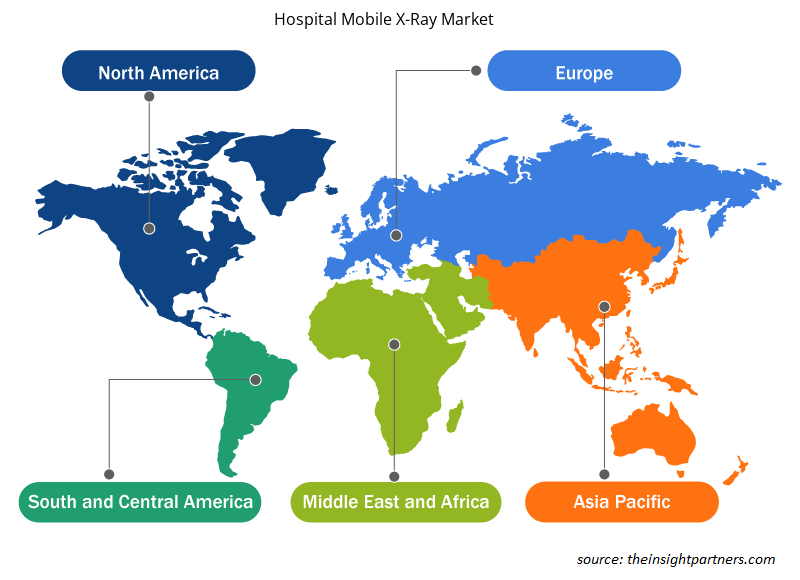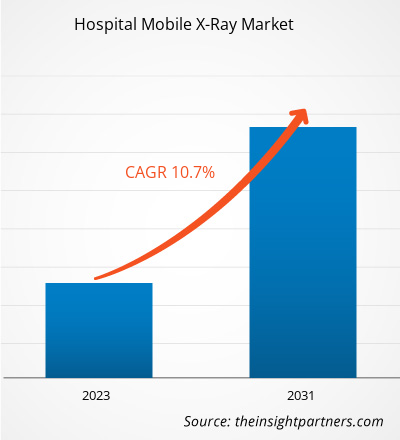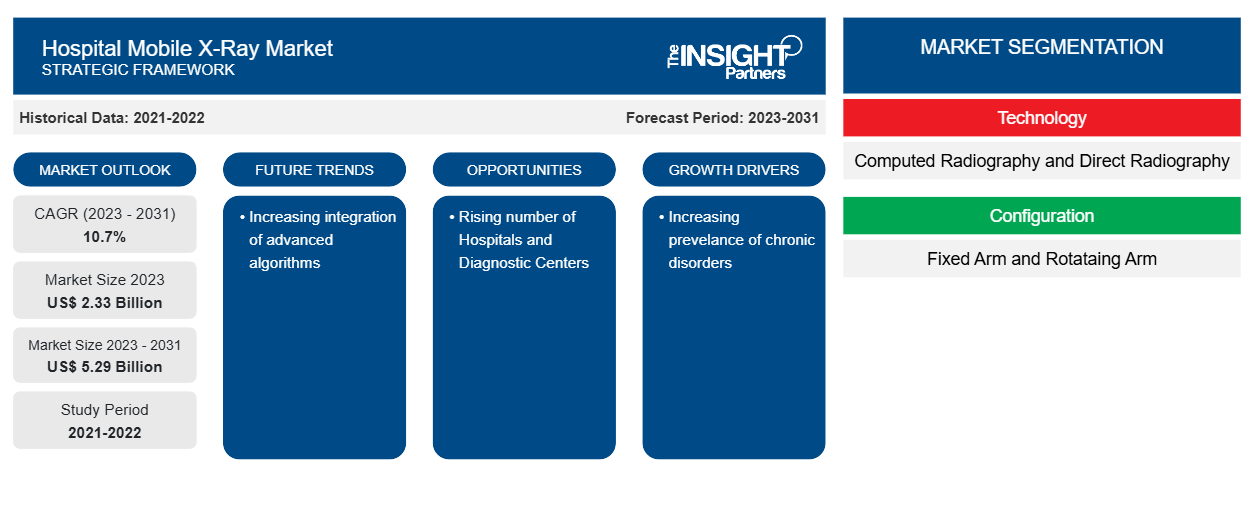Si prevede che il mercato dei raggi X mobili ospedalieri raggiungerà i 5,29 miliardi di dollari entro il 2031, rispetto ai 2,33 miliardi di dollari del 2023. Si prevede che il mercato registrerà un CAGR del 10,7% nel periodo 2023-2031. Il crescente numero di lanci di prodotti e la crescente integrazione di algoritmi avanzati per una migliore imaging rimarranno probabilmente tendenze chiave nel mercato dei raggi X mobili ospedalieri.CAGR of 10.7% during 2023–2031. The increasing number of product launches and the rising integration of advanced algorithms for better imaging are likely to remain key trends in the hospital mobile X-ray market.
Analisi del mercato dei raggi X mobili ospedalieri
La crescita del mercato dei raggi X mobili ospedalieri è guidata dalla crescente prevalenza di disturbi cronici e dalla crescente adozione di sistemi avanzati di raggi X mobili ospedalieri. C'è stato un enorme aumento della prevalenza di disturbi cronici, tra cui cancro, disturbi cardiovascolari e disturbi ortopedici e muscoloscheletrici. Tali condizioni hanno avuto effetti negativi su vaste popolazioni a livello globale, il che ha deprezzato la qualità della vita. Secondo l'Organizzazione mondiale della sanità (OMS), nel 2022, circa 1,71 miliardi di persone in tutto il mondo sono state colpite da disturbi muscoloscheletrici. Un aumento dei lanci di prodotti spinge anche la crescita del mercato.
Panoramica del mercato dei raggi X mobili ospedalieri
Negli ospedali, i sistemi radiologici mobili vengono utilizzati per la diagnosi di varie condizioni croniche. Inoltre, si prevede che il numero crescente di ospedali e centri diagnostici e la crescente integrazione di algoritmi avanzati per una migliore imaging creeranno ampie opportunità per il mercato dei raggi X mobili ospedalieri. È probabile che il Nord America rappresenti la quota di mercato maggiore durante il periodo di previsione. Si prevede che l'Asia Pacifica registrerà il CAGR più elevato nei prossimi anni.
Personalizza questo report in base alle tue esigenze
Riceverai la personalizzazione gratuita di qualsiasi report, comprese parti di questo report, o analisi a livello nazionale, pacchetto dati Excel, oltre a usufruire di grandi offerte e sconti per start-up e università
-
Scopri le principali tendenze di mercato in questo rapporto.Questo campione GRATUITO includerà analisi di dati che spaziano dalle tendenze di mercato alle stime e alle previsioni.
Driver e opportunità del mercato dei raggi X mobili ospedalieri
Maggiore adozione di radiografie mobili ospedaliere per favorire il mercato
L'adozione crescente di sistemi radiologici mobili avanzati offre vantaggi ai medici e ai pazienti. Uno dei principali vantaggi dei sistemi è la loro capacità di evitare spostamenti e trasporti extra di pazienti affetti da gravi condizioni di salute. La maggior parte dei sistemi radiologici mobili è dotata di un supporto su ruote, mentre alcuni sistemi sono motorizzati, il che consente ai tecnici di trasportare il sistema radiologico in modo semplice e rapido. Inoltre, i sistemi radiologici digitali mobili consentono una rapida acquisizione ed elaborazione delle immagini con l'ausilio di software intuitivi. Inoltre, i risultati sono accessibili in tempo reale e possono essere condivisi direttamente con il medico del paziente, il che lo aiuta a procedere con ulteriori processi di trattamento. A marzo 2021, Fujifilm India Pvt. Ltd. ha lanciato il suo sistema di radiologia digitale mobile: FDR nano. Il sistema offre immagini ad alta risoluzione con basse dosi di raggi X in contesti sanitari. Abilita circuiti di riduzione del rumore che migliorano la granularità delle regioni a bassa densità e raggiungono un'elevata qualità dell'immagine.Fujifilm India Pvt. Ltd. launched its mobile digital radiology system – FDR nano. The system offers high-resolution imaging with low X-ray doses in healthcare settings. It enables noise reduction circuits that improve the granularity of low-density regions and achieve high image quality.
Aumento del numero di ospedali e centri diagnostici
Il sistema sanitario globale ha osservato un forte aumento nel settore diagnostico negli ultimi anni a causa della trasformazione dei sistemi sanitari. Inoltre, la popolazione in rapida crescita e la crescente prevalenza di condizioni croniche richiedono infrastrutture di qualità tra ospedali e centri diagnostici. Secondo i dati recenti pubblicati dall'American Hospitals Association, nel 2024, negli Stati Uniti ci sono circa 6.120 ospedali. Inoltre, secondo i dati pubblicati da The Economic Times, nel 2023, ci sono circa 70.000 ospedali in India. Inoltre, questi ospedali in India stanno enfatizzando l'adozione di tecnologie diagnostiche portatili per facilitare l'imaging medico e fornire una migliore esperienza al paziente.
Analisi della segmentazione del rapporto di mercato dei raggi X mobili ospedalieri
I segmenti chiave che hanno contribuito alla derivazione dell'analisi del mercato dei sistemi radiologici mobili ospedalieri sono tecnologia, configurazione e reparto.
- In base alla tecnologia, il mercato dei raggi X mobili ospedalieri è diviso in radiografia computerizzata e radiografia diretta. Il segmento della radiografia computerizzata ha detenuto una quota di mercato maggiore nel 2023.
- Per configurazione, il mercato è diviso in braccio fisso e braccio rotante. Il segmento del braccio fisso deteneva una quota maggiore del mercato nel 2023.
- In termini di reparto, il mercato dei raggi X mobili ospedalieri è segmentato in sale operatorie, terapia intensiva e terapia intensiva neonatale, reparti di radiologia centrale, reparti di emergenza, reparti di parto prematuro e altri. Il segmento delle sale operatorie ha dominato il mercato nel 2023.
Analisi della quota di mercato dei raggi X mobili ospedalieri per area geografica
L'ambito geografico del rapporto sul mercato dei sistemi radiologici mobili ospedalieri è suddiviso principalmente in cinque regioni: Nord America, Asia Pacifico, Europa, Medio Oriente e Africa, e Sud e Centro America.
Il Nord America ha dominato il mercato dei dispositivi mobili per radiografia ospedaliera. La crescita del mercato nella regione è attribuita alla crescente prevalenza di malattie croniche, agli sviluppi strategici degli operatori di mercato e al crescente turismo medico in Messico che richiede dispositivi medici avanzati e convenienti per scopi diagnostici e terapeutici. Inoltre, a causa dell'elevata spesa in R&S per le nuove tecnologie e della presenza di operatori di mercato globali, il Nord America domina il mercato globale dei dispositivi mobili per radiografia ospedaliera. Si prevede che l'Asia Pacifica registrerà il CAGR più elevato nei prossimi anni.CAGR in the coming years.
Approfondimenti regionali sul mercato dei raggi X mobili ospedalieri
Le tendenze regionali e i fattori che influenzano il mercato dei raggi X mobili ospedalieri durante il periodo di previsione sono stati ampiamente spiegati dagli analisti di Insight Partners. Questa sezione discute anche i segmenti e la geografia del mercato dei raggi X mobili ospedalieri in Nord America, Europa, Asia Pacifico, Medio Oriente e Africa e America meridionale e centrale.

- Ottieni i dati specifici regionali per il mercato dei raggi X mobili ospedalieri
Ambito del rapporto sul mercato dei raggi X mobili ospedalieri
| Attributo del report | Dettagli |
|---|---|
| Dimensioni del mercato nel 2023 | 2,33 miliardi di dollari USA |
| Dimensioni del mercato entro il 2031 | 5,29 miliardi di dollari USA |
| CAGR globale (2023-2031) | 10,7% |
| Dati storici | 2021-2022 |
| Periodo di previsione | 2023-2031 |
| Segmenti coperti |
Per tecnologia
|
| Regioni e Paesi coperti |
America del Nord
|
| Leader di mercato e profili aziendali chiave |
|
Densità dei player del mercato dei dispositivi radiologici mobili ospedalieri: comprendere il suo impatto sulle dinamiche aziendali
Il mercato dei raggi X mobili ospedalieri sta crescendo rapidamente, spinto dalla crescente domanda degli utenti finali dovuta a fattori quali l'evoluzione delle preferenze dei consumatori, i progressi tecnologici e una maggiore consapevolezza dei vantaggi del prodotto. Con l'aumento della domanda, le aziende stanno ampliando le loro offerte, innovando per soddisfare le esigenze dei consumatori e capitalizzando sulle tendenze emergenti, il che alimenta ulteriormente la crescita del mercato.
La densità degli operatori di mercato si riferisce alla distribuzione di aziende o società che operano in un particolare mercato o settore. Indica quanti concorrenti (operatori di mercato) sono presenti in un dato spazio di mercato in relazione alle sue dimensioni o al valore di mercato totale.
Le principali aziende che operano nel mercato dei sistemi radiologici mobili ospedalieri sono:
- Gruppo Agfa-Gevaert
- SEDECAL
- IMMAGINI MEDICHE IDETEC
- Koninklijke Philips NV
- SternMed GmbH
- Immagini DMS
Disclaimer : le aziende elencate sopra non sono classificate secondo un ordine particolare.

- Ottieni una panoramica dei principali attori del mercato dei raggi X mobili ospedalieri
Notizie e sviluppi recenti sul mercato dei raggi X mobili ospedalieri
Il mercato dei raggi X mobili ospedalieri viene valutato raccogliendo dati qualitativi e quantitativi dopo la ricerca primaria e secondaria, che include importanti pubblicazioni aziendali, dati associativi e database. Di seguito sono elencati alcuni degli sviluppi nel mercato dei raggi X mobili ospedalieri:
- L'azienda ha lanciato AeroDR TX m01, un sistema radiografico mobile dotato di una funzione di radiografia digitale dinamica wireless in Giappone. Il sistema consente la radiografia dinamica oltre alla radiografia statica convenzionale senza trasferire un paziente in una sala radiologica , il che aiuta a fornire un trattamento appropriato e a prevenire l'aggravamento dei sintomi. (Fonte: Konica Minolta, Inc., Comunicato stampa/Sito Web aziendale 2022)
- L'azienda ha lanciato il suo sistema radiografico mobile digitale MobileDaRt Evolution MX8 Version v type all'American Healthcare Radiology Administrators (AHRA) Annual Meeting and Exposition, tenutosi a Phoenix negli Stati Uniti. È dotato di GLIDE Technologies, un'assistenza motorizzata proprietaria che consente un funzionamento fluido e agile con curve strette. Ad oggi, per adattarsi alla struttura medica, l'azienda ha fornito tre tipi di unità DR con diversi tipi di rilevatori di raggi X digitali (FPD: rilevatore a pannello piatto) e un sistema digitale integrato. (Fonte: Shimadzu Corporation, comunicato stampa/sito Web aziendale 2022)
- L'azienda ha lanciato il suo Mobilett Impact all'European Congress of Radiology (ECR) di Vienna. Il sistema combina tutti i vantaggi di un sistema radiografico mobile per condurre l'imaging al capezzale del paziente con un'integrazione digitale completa e un prezzo economico. Con Mobilett Impact, non solo l'imaging in sé, ma l'intero flusso di lavoro di imaging può essere eseguito direttamente al capezzale del paziente. (Fonte: Siemens Healthineers AG, comunicato stampa/sito Web aziendale 2022)
Copertura e risultati dei referti radiografici mobili dell'ospedale
Il rapporto "Dimensioni e previsioni del mercato dei raggi X mobili ospedalieri (2021-2031)" fornisce un'analisi dettagliata del mercato che copre le seguenti aree:
- Dimensioni e previsioni del mercato dei raggi X mobili ospedalieri a livello globale, regionale e nazionale per tutti i principali segmenti di mercato coperti dall'ambito
- Tendenze del mercato dei raggi X mobili ospedalieri e dinamiche di mercato come driver, restrizioni e opportunità chiave
- Analisi dettagliata delle cinque forze PEST/Porter e SWOT
- Analisi del mercato dei raggi X mobili ospedalieri che copre le principali tendenze del mercato, il quadro globale e regionale, i principali attori, le normative e i recenti sviluppi del mercato
- Analisi del panorama industriale e della concorrenza che copre la concentrazione del mercato, l'analisi della mappa di calore, i principali attori e gli sviluppi recenti per il mercato dei raggi X mobili ospedalieri
- Profili aziendali dettagliati
- Analisi storica (2 anni), anno base, previsione (7 anni) con CAGR
- Analisi PEST e SWOT
- Valore/volume delle dimensioni del mercato - Globale, Regionale, Nazionale
- Industria e panorama competitivo
- Set di dati Excel
Report recenti
Rapporti correlati
Testimonianze
Motivo dell'acquisto
- Processo decisionale informato
- Comprensione delle dinamiche di mercato
- Analisi competitiva
- Analisi dei clienti
- Previsioni di mercato
- Mitigazione del rischio
- Pianificazione strategica
- Giustificazione degli investimenti
- Identificazione dei mercati emergenti
- Miglioramento delle strategie di marketing
- Aumento dell'efficienza operativa
- Allineamento alle tendenze normative























 Ottieni un campione gratuito per - Mercato dei sistemi radiologici mobili ospedalieri
Ottieni un campione gratuito per - Mercato dei sistemi radiologici mobili ospedalieri